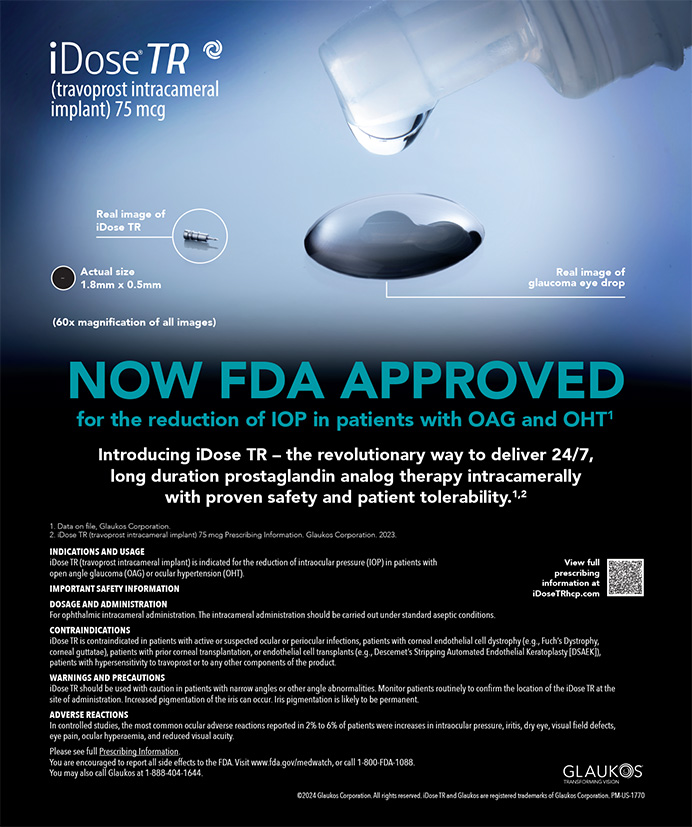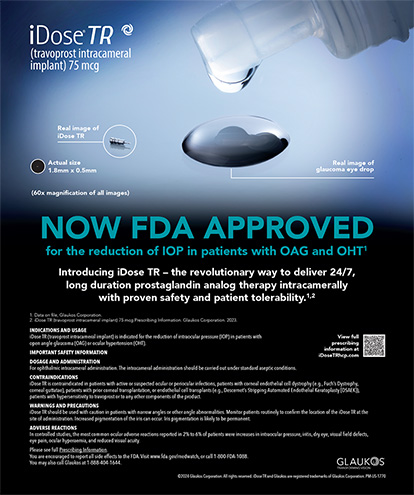Refractive Surgery | Aug 2005
Limbal Registration
True limbal registration is important for customized ablations.
Eric D. Donnenfeld, MD
In order to achieve true customized ablation, preoperative wavefronts must be captured and matched to the patient's cornea, a process called registration. To have true registration, surgeons need a point on the eye that will not move.
Since its debut, the Ladarvision excimer laser (Alcon Laboratories, Inc., Fort Worth, TX) has been the only wavefront-guided laser to have the capability of registration. Alcon Laboratories, Inc., developed the system to allow for true registration, which permits surgeons to measure the patient's corneal aberrometry preoperatively and then match these measurements against the patient's cornea at the time of surgery to ensure that they are applying the wavefront-guided correction to the appropriate area of the patient's eyes.
HOW IT WORKS
To achieve an optimal outcome, surgeons must register initial wavefront measurements to a fixed feature on the patient's eye and then apply the planned ablation profile to corresponding locations on the patient's cornea. With the Customcornea system (Alcon Laboratories, Inc.), surgeons dilate the patient's pupil, mark the limbus, and refer to the limbus before taking wavefront measurements at the aberrometer. When the patient is ready for surgery, the surgeon matches the limbal reference with the actual limbal mark on the patient's eye, thus ensuring accurate centration and registration. Aligning the preoperative marks prevents cyclotorsion and translation. A new advance on the Ladarvision system is automatic pupillary centration and registration, which allow automatic and speedier processing of multiple images with one-click accuracy.
OUTCOMES
Limbal registration was not as important with conventional LASIK as it is for customized ablations. With customized LASIK, registration is crucial to ensuring the best possible patient outcomes. In my practice, many of my patients achieved 20/20 or better with less glare and halos. Various studies have shown that patients experience a significant gain in their postoperative BCVA with Customcornea's limbal registration.1-3
I use the Ladarvision 4000 excimer laser (Alcon Laboratories, Inc.) almost exclusively for handling complex eyes, such as those that have an irregular cornea or a preexisting abnormal wavefront ablation that needs correction. With the Ladarvision 4000, I know I will be treating the correct area of the patient's cornea.
Other laser systems such as those by Visx, Incorporated (Santa Clara, CA), and Bausch & Lomb (Rochester, NY) do not offer the same type of registration as the Ladarvision system. Rather, they offer centration devices that lock onto the pupil. With these systems, problems might occur while capturing a patient's preoperative wavefront measurement with his pupil dilated under dark illumination. When the patient receives laser treatment, the illumination under the operating microscope may be brighter and cause the pupil to constrict. As a result, the surgeon might apply the laser treatment to the wrong area of the cornea. However, the Visx Iris Registration technology was recently approved to compensate for cyclotorsional movement from wavefront acquisition to laser ablation and for shifts in the centroid of the pupil in different lighting.
CASE STUDY
A 35-year-old white male who had undergone an initial treatment for myopic astigmatism with a different, conventional laser more than 3 years previously presented to me with complaints of blurry vision and glare is his left eye. The ablation zones were small, and there were significant higher-order aberrations. I performed an enhancement procedure using the Ladarvision Customcornea on his left eye. The patient achieved a UCVA of 20/15 postoperatively and large reductions in glare and halos. Preoperatively, the patient had an RMS value of 1.03µm, higher-order aberrations of 0.24µm, spherical aberrations of 0.8µm, and coma of 0.19µm One month after receiving the enhancement, the patient achieved an RMS value of 0.40µm, higher-order aberrations of 0.17µm, spherical aberrations of 0.01µm, and coma of 0.11µm (Figure 1).
CONCLUSION
Automatic limbal registration is now the standard of care, and I believe the Ladarvision System with Customcornea offers the best registration available. Although new laser vision systems with other possible registration capabilities have recently been developed and proposed, the lack of peer-reviewed literature and historical experience, as well as the lack of availability of these systems in clinical practice, suggests a cautious approach to their use. The future of laser ablative surgery is customized treatments to reduce preoperative high-order aberrations and to prevent the formation of new aberrations. The most critical aspect of a customized ablation is accurate registration. The Ladarvision system offers the most advanced system available today with the ability to improve results in the future.
Eric D. Donnenfeld, MD, is a partner in Ophthalmic Consultants of Long Island and is Co-Chairman of Corneal and External Disease at the Manhattan Eye, Ear, and Throat Hospital in New York. He is a consultant and performs research for Alcon Laboratories, Inc., but he states that he holds no financial interest in the products mentioned herein. Dr. Donnenfeld may be reached at (516) 766-2519; eddoph@aol.com.
1. Solomon K. CustomCornea vs. CustumVue. Presented at: The ASCRS/ASOA Symposium on Cataract, IOL and Refractive Surgery; May 3, 2004; San Diego, CA.
2. Slade S. Contralateral study of CustomCornea vs. CustomVue. Presented at: The ASCRS/ASOA Symposium on Cataract, IOL and Refractive Surgery; May 3, 2004; San Diego, CA.
3. Speaker M, Tullo W. Custom LASIK Outcomes: CustomCornea vs. CustomVue. Presented at: The ASCRS/ASOA Symposium on Cataract, IOL and Refractive Surgery; May 3, 2004; San Diego, CA.


